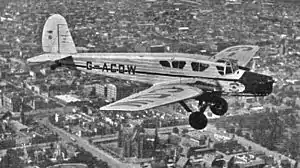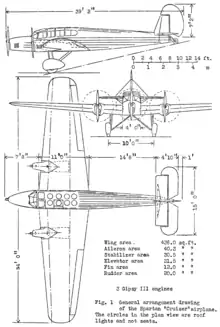Spartan Cruiser
The Spartan Cruiser was a 1930s British three-engined transport monoplane for 6 to 10[1] passengers built by Spartan Aircraft Limited at East Cowes, Isle of Wight. It was a development of the Saro-Percival Mailplane for passenger use.
| Cruiser | |
|---|---|
 | |
| Spartan Cruiser over Melbourne, 1934 | |
| Role | Light Transport |
| Manufacturer | Spartan Aircraft Limited |
| Designer | Edgar Percival |
| First flight | 1932 |
| Introduction | 1933 |
| Retired | 1942 |
| Primary users | Spartan Air Lines British Airways Ltd |
| Number built | 17 |
| Developed from | Spartan A.24 Mailplane |
Design and development
The Saro-Percival Mailplane was a three-engined monoplane mail plane designed by Edgar Percival, and built by Saunders-Roe Limited (Saro) at Cowes in 1931, the aircraft first flying early in 1932. It was a low-winged monoplane, with a wooden wing[2] and plywood fuselage, and was powered by three 120 hp (89 kW) de Havilland Gipsy III engines.[3] When Saro was financially re-organised, Percival sold his interest in the aircraft to Saro, who re-designated it as the Saro A.24 Mailplane. Due to the close ties between Saro and Spartan Aircraft, the development of the aircraft was transferred to Spartan, and the aircraft was re-designated again as the Spartan Mailplane.[4] The aircraft was modified to accommodate two passenger seats. Starting on 15 June 1932, the Mailplane (G-ABLI) flew from Stanley Park Aerodrome (Blackpool) to Karachi, India taking a total of 5 days 23 hours 50 minutes.[5]
The Mailplane had seen no commercial interest, so the design was re-worked as a passenger carrier. This re-designed aircraft was designated the Spartan Cruiser, and the prototype (G-ABTY) first flew in May 1932, piloted by Louis Strange. The original three-engined low-wing format had been retained, but the plywood fuselage was replaced with an all-metal fuselage to carry six passengers and two crew.[4]
Just one example was built of the basic Cruiser (G-ABTY, later known as the Cruiser I). Both the new Cruiser and the Mailplane were displayed at the first Society of British Aircraft Constructors (SBAC) Show at Hendon Aerodrome on 27 June 1932. It was then used for demonstrations, including a 3,593-mile European sales tour. The Yugoslavia airline Aeroput ordered two aircraft and a licence to build further examples in Yugoslavia[5] at the Zmaj aircraft factory.[6]
The Cruiser was re-designed as the Spartan Cruiser II, featuring a modified fuselage and cockpit. The first Cruiser II (G-ACBM) flew in February 1933, powered by Cirrus Hermes IV engines, and G-ACKG/VT-AER[7] also used that engine type. Most Spartan-built Cruiser IIs were powered by three Gipsy Major engines, but G-ACOU/OK-ATM was powered by Walter Major engines. In 1933 and 1934, twelve Cruiser IIs were built by Spartan, five of which were exported.[4] Just one licence-built Cruiser II (YU-SAP)[8] was built in Zemun, Yugoslavia, by Zmaj Aircraft, in 1935.[9][10]
One further development was the Spartan Cruiser III, with an aerodynamically-refined fuselage accommodating eight passengers, a modified windscreen and a trousered main undercarriage. Only three Cruiser IIIs were built (G-ACYK, G-ADEL and G-ADEM), for Spartan Air Lines.[4]
Operational history
Spartan Air Lines Ltd was formed to operate Cruisers between London and Cowes, Isle of Wight. In April 1933, Spartan Air Lines initially operated the one Cruiser I (G-ABTY) and two Cruiser IIs (G-ACDW and G-ACDX) from Heston Aerodrome.[4] Iraq Airwork Limited ordered one aircraft for an experimental air route between Baghdad and Mosul, with a further aircraft being ordered by Misr Airwork, the Egyptian branch of Airwork.[5] Two Cruiser IIs and one Cruiser III were impressed into RAF service in 1940.[4]
Operators
Civil operators
- Misr Airwork Limited
- Maharajah of Patiala
- Iraq Airwork Limited
- British Airways Limited (1936-1940)
- Northern and Scottish Airways (1936)
- Railway Air Services (1936)[4]
- Scottish Airways (1936-1938)
- Spartan Air Lines (1933-1935)
- United Airways (1934)[11]
Military operators
- Royal Yugoslav Air Force - Two aircraft impressed into military service in 1940.
Surviving aircraft
The fuselage of a Cruiser III (G-ACYK) is on display at the National Museum of Flight, East Fortune, Scotland. This aircraft crashed in 1938; in 1973, the cabin section was moved by helicopter from the crash site near Largs to the museum.[12]
Specifications (Cruiser II)

Data from British Civil Aircraft since 1919 [4]
General characteristics
- Crew: Two
- Capacity: Six passengers
- Length: 39 ft 2 in (11.94 m)
- Wingspan: 54 ft 0 in (16.46 m)
- Height: 10 ft 0 in (3.05 m)
- Wing area: 436 sq ft (40.50 m2)
- Empty weight: 3,650 lb (1,656 kg)
- Max takeoff weight: 6,200 lb (2,812 kg)
- Powerplant: 3 × de Havilland Gipsy Major inverted inline piston engine, 130 hp (97 kW) each
Performance
- Maximum speed: 133 mph (214 km/h, 115.5 kn)
- Cruise speed: 115 mph (185 km/h, 100 kn)
- Range: 310 mi (499 km, 270 nmi)
- Service ceiling: 15,000 ft (4,570 m)
- Rate of climb: 630 ft/min (3.2 m/s)
Notes
- Flight 1933
- Cruiser wing under construction Archived 8 October 2011 at the Wayback Machine
- Flight 10 July 1931
- Jackson (1988), pp.188-191.
- Lowe (1994), pp.52-53.
- Yugoslavia - The Aviation Industry at aeroflight.co.uk, Retrieved 4 December 2013
- VT- is the prefix for Indian registered aircraft - in this case the aircraft was owned by His Highness the Maharaja of Patiala
- Image of YU-SAP
- Zmaj Aircraft
- Zmaj aircraft company
- http://www.flightglobal.com/pdfarchive/view/1935/1935%20-%201087.html Flight, 5 May 1935
- "Spartan Cruiser forward fuselage". National Museums Scotland. Retrieved 28 July 2020.
References
- The Illustrated Encyclopedia of Aircraft (Part Work 1982-1985). Orbis Publishing.
- Jackson, A.J. (1974). British Civil Aircraft since 1919 Volume 3. London: Putnam. ISBN 0-370-10014-X.
- Jackson, A.J. (1988). British Civil Aircraft since 1919 Volume 3. London: Putnam. ISBN 0-85177-818-6.
- Janić, Čedomir; O. Petrović (2011). Short History of Aviation in Serbia. Beograd: Aerokomunikacije. ISBN 978-86-913973-2-6.
- Lowe, Malcolm V. (1994). "Island Hopper: The Spartan Aircraft Cruiser tri-motor". Air Enthusiast. No. 56, Winter 1994. Stamford, UK: Key Publishing. pp. 52–55. ISSN 0143-5450.
- "TheSpartan Cruiser". flightglobal.com. 22 July 1932.